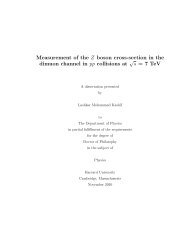2 The CDF Experiment at Fermilab Contents - Harvard University ...
2 The CDF Experiment at Fermilab Contents - Harvard University ...
2 The CDF Experiment at Fermilab Contents - Harvard University ...
Create successful ePaper yourself
Turn your PDF publications into a flip-book with our unique Google optimized e-Paper software.
Section 2: <strong>CDF</strong> Hardware Projects 5<br />
2.2 Hardware Upgrade Projects<br />
<strong>The</strong> upgrades of the <strong>CDF</strong> appar<strong>at</strong>us are substantial. All of the tracking is being replaced,<br />
and the <strong>Harvard</strong> group is involved in the two most important tracking subsystems: the<br />
Central Outer Tracker (COT) and the Silicon Vertex detector (SVX). It also carries<br />
full responsibility for the Central Muon Extension (CMX) which it built as an upgrade<br />
to the muon system during Run I. Each of these projects is described below.<br />
Much of the success of these undertakings is <strong>at</strong>tributable to the excellent support sta<br />
<strong>Harvard</strong> enjoys. John Oliver and N<strong>at</strong>han Felt are responsible for the design of many important<br />
electronics modules and systems, in particular, for parts of the d<strong>at</strong>a acquisition system<br />
for the SVX. Jack O'Kane and Sarah Harder fashioned quickly and reliably many of the<br />
boards and electronic devices needed by the <strong>Harvard</strong> <strong>CDF</strong> group. <strong>The</strong> skills and dedic<strong>at</strong>ion<br />
of Rick Haggerty and Steve Sansone in the machine shop guarantee the success of the COT<br />
project of the CMX.<br />
2.2.1 Central Outer Tracker (COT)<br />
(Prof. Franklin, Dr. Burkett, Dr. Riegler, Mr. Hall, Ms. Madrak & Ms. Wessels)<br />
Overview of Central Outer Tracker<br />
<strong>CDF</strong> is upgrading detectors and electronics to handle luminosities higher than in previous<br />
runs. <strong>The</strong> higher luminosity will be achieved by both increasing the number of proton<br />
bunches, and by using a more ecient injector (the Main Injector) to the superconducting<br />
synchrotron. At the beginning of Run II, the bunches will cross <strong>at</strong> <strong>CDF</strong> every 396 ns, and<br />
in Run IIb, every 132 ns. <strong>The</strong> central tracking chamber in <strong>CDF</strong> Run 1 was known as the<br />
CTC. <strong>The</strong> upgraded design, the Central Outer Tracker (COT), is similar to the CTC but<br />
improves upon identied deciencies and accommod<strong>at</strong>es the higher luminosity of Run II.<br />
<strong>The</strong> maximum drift time has been reduced from 706 ns to 100 ns which means th<strong>at</strong> events<br />
will not overlap in the chamber. This is accomplished both by reducing the maximum drift<br />
distance from 3.6cm to 0.88cm and by using a faster gas, Argon-Ethane-CF 4 (50:35:15).<br />
<strong>The</strong> number of stereo layers has been increased from 24 to 48, which will improve tracking<br />
resolution in the r , z plane. <strong>The</strong> CTC was segmented into nine super-layers, ve axial and<br />
four stereo. <strong>The</strong> ve axial super-layers consisted of 12 sense wire layers, while the four<br />
stereo super-layers consisted of only 6 sense wire layers. Thus there were only 24 stereo















